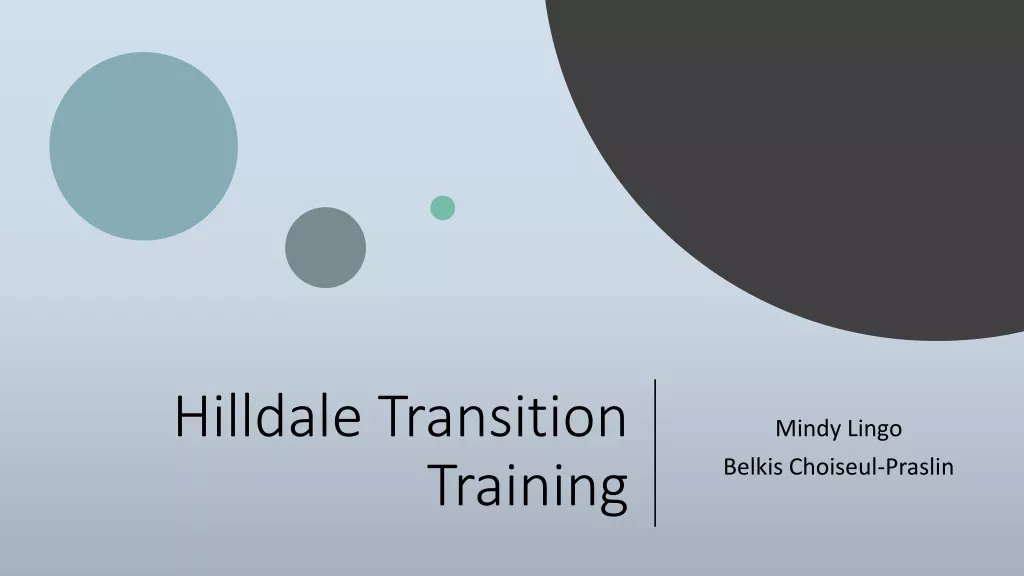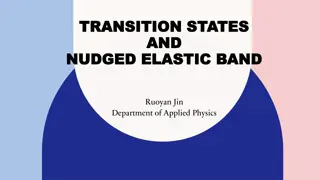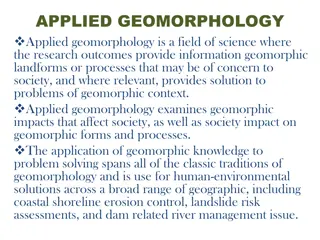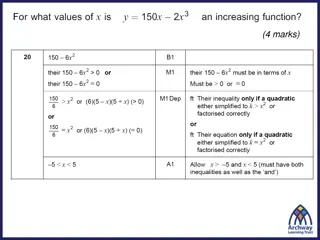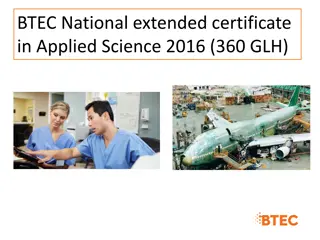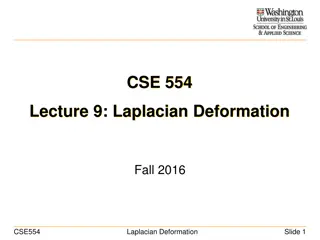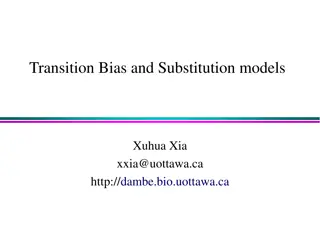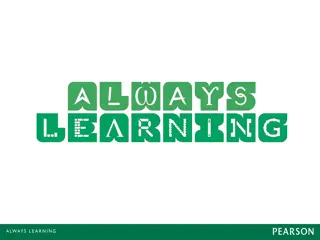Transition to BTEC Applied Science: Key Points and Overview
Preparation and determination are crucial when transitioning from GCSE to BTEC Applied Science. This presentation covers course information, the structure of the BTEC Applied Science Diploma and Extended Certificate, grading systems, unit breakdowns, and the importance of being resilient in pursuing scientific knowledge.
Download Presentation

Please find below an Image/Link to download the presentation.
The content on the website is provided AS IS for your information and personal use only. It may not be sold, licensed, or shared on other websites without obtaining consent from the author.If you encounter any issues during the download, it is possible that the publisher has removed the file from their server.
You are allowed to download the files provided on this website for personal or commercial use, subject to the condition that they are used lawfully. All files are the property of their respective owners.
The content on the website is provided AS IS for your information and personal use only. It may not be sold, licensed, or shared on other websites without obtaining consent from the author.
E N D
Presentation Transcript
Transition from GCSE to BTEC Applied Science Before anything preparation is the key to success Alexander Graham Bell
Contents of this PowerPoint Contents of this PowerPoint Slides 3-8 Slides 9-14 Slides 15-18 Slides 19-22 Slide 23 Slides 24-28 Slides 29-30 Slides 31-34 Slides 35-36 Slides 37-40 Course Information Mathematical skills Mathematical skills test yourself Biology preparation - cells Biology preparation test yourself Chemistry preparation Chemistry preparation test yourself Physics preparation Physics preparation test yourself Appendices
Course information First principle: Never let ones self be beaten down by persons or events Marie Curie
BTEC Diploma and Extended Certificate BTEC Diploma and Extended Certificate The BTEC Applied Science Diploma is the equivalent of two A- level awards. The Extended Certificate is the equivalent of one A-level award. To see how grades compare in terms of UCAS points, please see Appendix three.
BTEC Applied Science Diploma BTEC Applied Science Diploma The Course consists of 8 units: Number of Unit Name of unit Exam or coursework 1 Principles and Applications of Science 1 Exam 2 Practical Scientific Procedures and Techniques Coursework 3 Science Investigation Skills Exam 4 Laboratory Techniques and their Application Coursework 5 Principles and Applications of Science 2 Exam 6 Investigative Project Coursework 8 Physiology of Human Body Systems Coursework 9 Human regulation and reproduction Coursework
BTEC Applied Science Diploma BTEC Applied Science Diploma - - continued continued The overall grade awarded depends on the grades attained for each of the units completed. Each unit result generates a corresponding number of points. These points are added and the total number of points achieved corresponds to the grades in the table. Total number of points achieved Overall grade for the course U 0 PP 72 MP 88 MM 104 DM 124 DD 144 D*D 162 D*D* 180 Please see appendices for more details on the number of points per unit.
BTEC Applied Science Extended Certificate BTEC Applied Science Extended Certificate The Course consists of 4 units: Number of Unit Name of unit Exam or coursework 1 Principles and Applications of Science 1 Exam 2 Practical Scientific Procedures and Techniques Coursework 3 Science Investigation Skills Exam 8 Physiology of Human Body Systems Coursework
BTEC Applied Science Extended certificate BTEC Applied Science Extended certificate - - continued continued The overall grade awarded depends on the grades attained for each of the units completed. Each unit result generates a corresponding number of points. These points are added and the total number of points achieved corresponds to the grades in the table. Total number of points achieved Overall grade for the course U 0 P 36 M 52 D 74 D* 90 Please see appendices for more details on the number of points per unit.
Mathematical skills It s not that I m smart, I just stay with problems for longer. Albert Einstein
Calculating Calculating Averages Averages In Applied Science you are expected to calculate the mean of experimental results. This means calculating the sum of the results and dividing this by the number of results. You are expected to remove anomalies from calculations of mean. These are results that do not fit the pattern or trend. These anomalies would be highlighted in tables of results. The higher grades are awarded if anomalous results are retested.
Key Points Tabulation Tabulation Headings should list the variable tested, or the equation being performed and the unit. The unit should NOT be repeated with the values Dependent variable Unit Independent variable Time (s) Distance travelled (cm) 0 60 120 180 240 300 360 0 46 70 85 94 96 96 The left hand column would normally record the independent values and the other columns those measured or calculated. Repeats and average columns should ALL contain both the variable and unit in the heading as shown below. 420 96 Values, these should be written to the level of precision allowed by the equipment used. Time (s) Distance travelled (cm) Brackets can be used for units Attempt 1 0 Attempt 2 0 Attempt 3 0 Average 0 0
Graphs skills Graphs skills When drawing lines of best fit, draw a smooth straight or curved line that passes through the majority of the points. If you can, try to have an even number of points above and below the line if it can t go through all points.
Describing Describing graphs graphs Usually the x axis plots the independent variable and the y axis plots the dependent variable. When describing the trend, use the phrase . As X increases, Y increases/decreases in a linear/non-linearfashion. Between A and B, as time increases, distance increases in a linear fashion. Substitute the quantities into X and Y, and choose either of the two options to describe the graph.
Converting Units Multiplication factor Prefix Symbol 1 000 000 000 = 109 Giga G Divide by 1000 for each conversion in this direction. E.g 1m / 1000 = 0.001km Multiply by 1000 for each conversion in this direction. E.g 1km x 1000 = 1000m 1 000 000 = 106 Mega M 1000 = 103 Kilo k 1 = 1 0.001 = 10-3 Milli m 0.000001 = 10-6 Micro 0.000000001 = 10- 9 Nano n Please note that Centi is only 100x smaller than a metre not 1000x (10-2)
Value 1 Value 2 Value 3 Average 33.0 33.2 33.9 93 82 94 Test your knowledge 0.0056 0.0062 0.0058 45.7 39.8 46.8 73.08 69.21 67.2 Calculate the average of the results above. Circle and remove any results that don t fit the pattern or trend from your calcuations
Description: The experiment is measuring the extension in metres of a spring when forces are added to it. The following forces will be added: 0N, 1N, 2N, 3N, 4N, 5N Test your knowledge The experimenter plans to repeat the experiment three times and calculate an average extension for the spring Design a table that would enable you to collect results for the experiment described above
Test your knowledge Draw lines of best fit for both of the graphs shown above
Test your knowledge Fully describe the graph above using the correct terms.
Biology preparation - cells It is a cursed evil to any man to become as absorbed in any subject as I am in mine. Charles Darwin
Cell organelles and functions Animal cell
Cell organelles Plant cell
Make a list of the cell labels you are familiar with from GCSE Test your knowledge Make an additional list of the labels present in the diagrams from this PowerPoint that you are unfamiliar with. Using the internet and the diagram of the plant cell add functions to the plant cell labels
Chemistry preparation Nothing is lost, nothing is created, everything is transformed. Antoine Lavoisier
Atomic structure Atomic structure refers to the structure of atom comprising of a nucleus in the centre. In the nucleus protons (positively charged) and neutrons (neutral) are present. The negatively charged particles called electrons revolve around the nucleus
Ions Ions are charged atomsNegative ions are created when atoms GAIN electron(s). Positive ions are created when atoms LOSE electron(s).
Calculating sub-atomic particles present The atomic number (2 in the case of Helium) determines the number of protons present in the atom. The Mass number (4 in the case of Helium) the atomic number determines the number of neutrons present in the atom The electrons if the atom is UNCHARGED are the same as the atomic number. If the atoms is negative charged extra electrons should be ADDED to the atomic number - corresponding to the charge I.e. Cl- is one extra electron O2- is two extra electrons If the atom is positively charged the electrons should be SUBTRACTED from the atomic number corresponding to charge.
Isotopes Isotopes contain the same number of protons and electrons, but a different number of neutrons.
Atom or ion Be Protons Neutrons Electrons Li Test your knowledge Ne Mg2+ O2- How many protons, neutrons and electrons are present
Test your knowledge How many protons, neutrons and electrons in the isotopes of carbon and uranium above?
Physics preparation It is theory that decides what can be observed. Albert Einstein
Waveform Important labels include: Wavelength Amplitude Node Crest / Peak Trough Node
Longitudinal waves The wave is also called a compression wave. The particles vibrate backwards and forwards to the direction of travel. Sound is an example of this type of wave.
Transverse waves The particles vibrate perpendicular (at 90o) to the direction of travel of the wave. The electromagnetic spectrum waves travel in this way.
Test your knowledge Give a definition for wavelength, node, crest, trough and amplitude
Test your knowledge Seismic waves consist of both longitudinal and transverse waves, explain the difference.
Appendices Science brings man closer to God. Louis Pasteur
Appendix slide 1 Appendix slide 1 Points available for Diploma only units
Appendix slide 2 Appendix slide 2 Points available for Extended certificate and diploma units
Appendix 3 Appendix 3 - - UCAS Grades for Extended certificate and diploma units UCAS Points compared to A Points compared to A- -level level Diploma Extended Certificate A level UCAS tariff points D*D* D*D DD 112 104 96 84 80 78 72 64 56 48 40 32 28 24 20 16 12 10 8 6 DM MM D* D A* A B C MP PP M D P E



